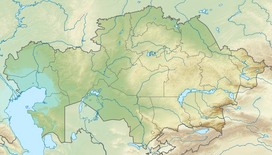Tarbagatai Mountains
| Tarbagatai | |
|---|---|
 Tarbagatai Location in Kazakhstan (on the border with China) | |
| Highest point | |
| Elevation | 2,992 m (9,816 ft) |
| Coordinates | 47°11′18″N 82°27′59″E / 47.18833°N 82.46639°ECoordinates: 47°11′18″N 82°27′59″E / 47.18833°N 82.46639°E |
| Naming | |
| Native name | Tarbaǵataı |
| Geography | |
| Location | China–Kazakhstan border |
| Countries | Kazakhstan and China |
The Tarbagatai Mountains (Mongolian: ᠲᠠᠷᠪᠠᠭᠠᠲᠠᠢ
ᠨᠢᠷᠤᠭᠤ, Тарвагатай нуруу, translit. Tarvagatai nuruu), literally: "range with marmots"); Chinese: 塔尔巴哈台山; pinyin: Tǎ'ěrbāhātái Shān; Kazakh: Тарбағатай жотасы, Tarbaǵataı jotasy) are a range of mountains located in the north-western parts of Xinjiang, China, and East Kazakhstan. The name of the mountain derived from Mongolian word: in Traditional Mongolian alphabet: Mongolian: ᠲᠠᠷᠪᠠᠭᠠ (тарвага "tarvaga", meaning "marmot") with suffix Mongolian: ᠲᠠᠢ (-тай "-tai"; literally "to have" or "with").
Many Tarbagan marmot live in this mountain range.[1] Their name does not have a direct translation from the English in Mongolian, as it would mean "marmot's marmot".
An eastern extension of the Tarbagatai is the Saur Range.
Drainage[]
As it is common for mountain ranges, there is more precipitation in the Tarbagatai mountains than in the adjacent flatlands. The mountains are thus an important watershed. Streams from the northern slopes of the Tarbagatai flow into Lake Zaysan, which eventually drains (via the Irtysh) into the Arctic Ocean. The streams of the southern slope, many of which merge into the Emil River, flow into the Emin Valley (the basin of the endorheic Lake Alakol); they are an important source of water for several counties of Tacheng (Tarbagatay) Prefecture in China.
References[]
- ^ Ognev, S.I. (1963). Mammals of Eastern Europe and Northern Asia: Rodents. Mammals of Eastern Europe and Northern Asia. Israel Program for Scientific Translations. p. 250. Retrieved 22 December 2020.
- Mountain ranges of Kazakhstan
- Mountain ranges of Xinjiang
- Kazakhstan geography stubs
- Xinjiang geography stubs
